 |
| This time we decided to come a day early so we spent the night at the Miami Hilton. |
 |
| Our balcony room aboard the Norwegian Pearl. I usually find beds too hard for me but this one was just right. |
 |
| Our balcony had two chairs and a small table. |
 |
| After our meal, we decided to explore. We found a bridge viewing room on deck 11 but the curtains on the windows into the bridge were closed. The little room included a model of the ship. |
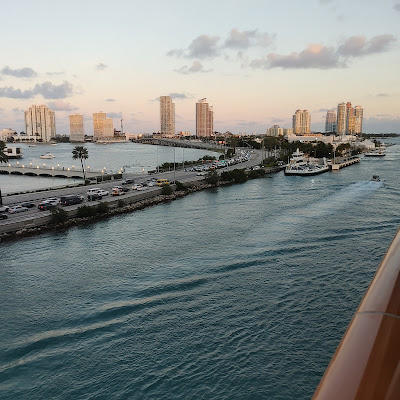 |
| Leaving Miami Cruise Port. The road is the MacArthur Causeway. |
 |
| Car ferry at the Fisher Island Ferry Terminal. |
 |
| Very interesting house over the water. |
 |
| Opposite side of a car ferry. |
 |
| Miami Beach US Coast Guard Base. |
 |
| Portofino Towers condominium |
 |
| South Pointe Beach |
 |
| We went to the show the first night on the ship. Loved the stage curtain. Show was good too. |
 |
| Every evening we got a flyer listing important information and an itinerary of the next day's events. |
 |
| I didn't find much to do on the first At Sea day. Went to trivia once. Took advantage of the bar package and drank some mud slides. |
 |
| Our first port, George Town, Grand Cayman, Cayman Islands. |
 |
| This port isn't big enough for ships to dock so we were tendered to the pier. |
 |
| Our first stop was Pedro St James, a private home built in 1870. It was the largest home on the island, much larger than the wattle and daub homes found in the area at the time of its construction. |
 |
| The bottom level was a dining and storage area. The second a living area, while the bedroom was on the top level. |
 |
| Ground floor |
 |
| Storage area on the ground level. |
 |
| Separate cook house. |
 |
| Time to head up to the second floor. |
 |
| Meetings were held at Pedro St James to negotiate the islands separation from Jamacia in 1962. |
 |
| Click on the photo if the print is too small to read. |
 |
| We reboarded our bus and headed back the way we came. Saw this gas station so I thought I would try to figure out how much in US dollars a gallon of gas costs. They use the imperial gallon which is 160 ounces or 1.2 US gallons. The Cayman Island dollar is worth about US$1.20. So Cayman $5.37 divided by 160 oz is .0335625/oz. Times 128 oz is Cayman$4.296 x 1.2 is US$5.156 per US gallon. The guide also told us that the electricity is diesel powered so it is expensive. We went past the airport which is serviced by many of the large airlines including, Jet Blue, American and United. We also went past the dump, the highest point on the island, where trash has been dumped since the 1960's. |
 |
| We climbed up the five-story tower for a look around the area. We could see the ocean on either side. |
 |
| Looking west. |
 |
| Looking east. |
 |
| The pedestrian walkway between the stores. |
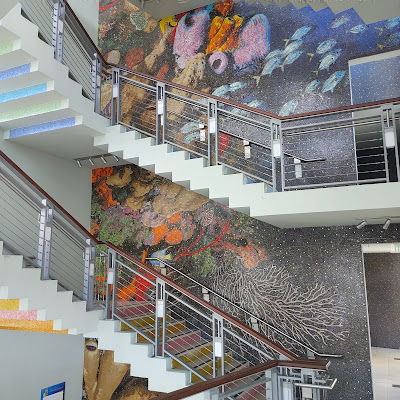 |
| To me the coolest thing about the tower was the tile work on the walls as we went down the stairs. |
 |
| We went into a couple stores. My sister thought all the sand timers needed to be turned over at this store. |
 |
| Official residence of His Excellency the Governor of the Cayman Islands. Officially named ‘Government House’, it is not open to the public. |
 |
| We can officially say we've been to Hell and back. We stopped here for a quick look. |
 |
| Although not part of the geological site, I thought this palm tree I could see from the parking lot was very interesting. Looks like it got knocked over but just kept growing. |
 |
| There were quite a few chickens running around the parking lot. Figure they are domestic animals that got loose at some point. Probably during a hurricane, as is the case in Hawaii. |
 |
| The geology is a little strange with its surrounding vegetation. |
 |
| Would the punishment be a trip to hell? |
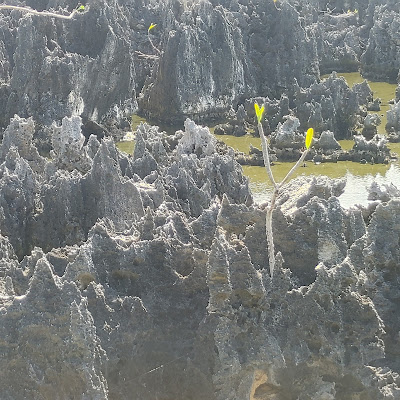 |
| Interesting how this tree was growing up in the formation. |
 |
| This rooster was more colorful. |
 |
| There were three other cruise ships in port while we were there. |
 |
| My sister's cell phone takes amazing photos. |
 |
| My group boarded a bus for our tour. There was a lot of traffic, and I didn't see many lane markings when I caught glimpses of the road. |
 |
| Parking did look a little tight. 😉 |
 |
| Looks like motorcycles could maneuver however they wanted to get through traffic. This one had come down the side of the road then cut in between these two cars to get to the front of the line. |
 |
| This place looked pretty nice... |
 |
| Until you zoomed in a little closer. |
 |
| Looks like street cleaners have a hazardous job. |
 |
| I'm assuming this guy was out collecting plastic to make money. |
 |
| We stopped at a section of the bastion called Baluarte (bastion in English) de Santa Barbara |
 |
| View of the fortress from the top of the bastion. |
 |
| Our open-air bus. |
 |
| More workers were cleaning around the bastion. |
 |
| Looks like these humps were used to separate the bike lane from the roadway. |
 |
| As we passed back over the lagoon, we could see a homeless encampment below the bridge. |
 |
| Gas station brand of this area. |
 |
| Arriving at the fortress, Castle San Felipe de Barajas. |
 |
| It's quite a steep climb to the top so we did it in stages. |
 |
| The fortress was actually built in stages between 1536 and 1767. |
 |
| Everything I read says the fortress was constructed using limestone, clay, mud and bricks. This looks like a fossilized coral that was contained within the limestone. |
 |
| Here are the bricks. |
 |
| Looking toward Bocagrande. |
 |
| The black building was the old Circo Teatro bull ring that has been converted into a shopping center. |
 |
| Looking towards the hills where most of the poorest people live. |
 |
| We headed up the tunnel. |
 |
| View at the top of the tunnel. |
 |
| Behind the tunnel mouth. |
 |
| Looking at where the tunnel emerges from below. |
 |
| Entrance to the well. |
 |
| Looking down on later parts of the fortress. |
 |
| Bell tower. |
 |
| In 1984 UNESCO listed the castle, along with the Old City of Cartagena, as a World Heritage Site |
 |
| For a more complete description of the fortress and is history, check out this website - https://www.cartagenaexplorer.com/history-castillo-san-felipe-fortress-cartagena-colombia/ |
 |
| Our guide told us we could see our cruise ship from the top of the fort. Well, I see the cranes at the container dock. |
 |
| Maybe if I had a better camera, I could have gotten a photo of the ship, but I think it might be there in the break between the buildings. |
 |
| On the other side is the Parque Centenario, created to celebrate one hundred years of independence from Spanish rule. |
 |
| Once again the vendors gathered as the bus came to a stop. |
 |
| The clock tower at the entrance to the walled city. |
 |
| Turning to look at the Camellon de los Martires as we headed toward the walled city. |
 |
| Once we entered the walled city, I took photos of some plaques on the wall. The guide said we were in Carriage Square where the 1501 expedition landed. |
 |
| Within the walls is an impressive collection of colonial and republican-era buildings. The colonial style buildings are characterized by their red roofs. |
 |
| I didn't see a lot of them, but pigeons are everywhere you go. |
 |
| Christopher Columbus Monument in Plaza de la Aduana |
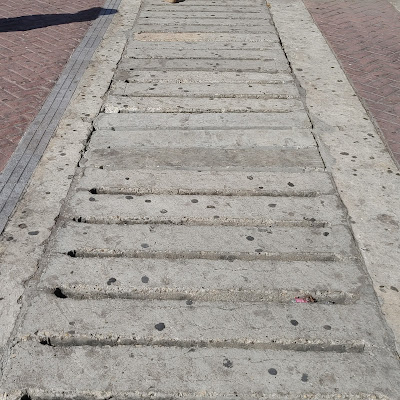 |
| Slotted concrete storm drains |
 |
| The home of the Major of Cartagena, or Alcaldia Mayor de Cartegena. |
 |
| I wonder how many people per day trip over those stone borders. |
 |
| Church built was built between 1580 and 1654 and named after the saint. |
 |
| Looking toward the Cathedral of Santa Catalina de Alejandría. |
 |
| The dance took place in this narrow street while our guide held up the traffic. |
 |
| Next stop was Plaza de la Proclamación. |
 |
| On the other side of the plaza, we entered the Catedral de Santa Catalina de Alejandría. This is a side entrance. |
 |
| This is what the front of the church looked like. |
 |
| One of many of reliefs on the walls. |
 |
| Loved the multicolored tile on this roof. |
 |
| There were many food carts selling sliced fruit. |
 |
| We ended up back at the clocktower. |
 |
| Front view of the large "doll" Christmas decoration |
 |
| Inside the "doll's skirt". |
 |
| Notice how it was lit with string lights. |
 |
| On the other side of Avenida Calla 24 Real were two large statues of pegasi. We walked past the Convention Center and stopped for a rum and chocolate tasting. |
 |
| I took this photo of a statue as the bus drove by but I never found any information on it. It is by the Convention Center parking lot. Google maps didn't show it there so maybe it is new. |
 |
| Interesting electrical / phone wires. |
 |
| If you want to know more of the history of Cartagena, I found the following website to be very informative. https://www.cartagenaexplorer.com/history-of-cartagena-comprehensive/ |
 |
| There were buses to take people to the ship, but it was close enough that I just walked. |
 |
| Back in the cabin, I stepped out onto the balcony to watch containers being placed onto flatbeds. |
 |
| The Atlantic Bridge was completed in 2019 and is the third bridge over the canal after the Bridge of the Americas and the Centennial Bridge, both on the Pacific side of the canal. |
 |
| By the time I was taking note of our surroundings, we were passing under the bridge. |
 |
| All the rails were crowded with people and the crowd was five people deep at the bow. Some of the decks had plexiglass barriers that were hard to see through due to condensation. |
 |
| The original locomotives were GE and the current ones are Mitsubishi. Each has two motors, one for forward movement and one for backing. |
 |
| Looking back we can see a tug escorting the next ship in line. |
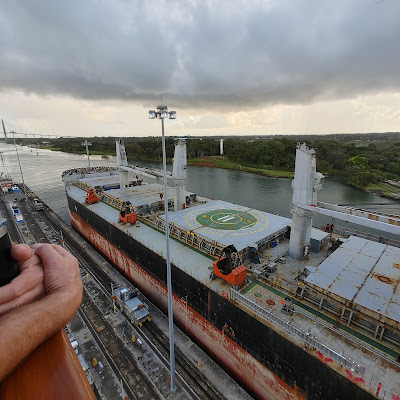 |
| As we enter the first lock chamber, a ship is exiting in the opposite direction. The Panama Canal Authority estimates that each transit through the canal uses 52 million gallons of water. |
 |
| See the next northbound ship in the lock ahead of us? |
 |
| We could see the view from the bow camera on the TV in our cabin. |
 |
| There wasn't much room on each side between the ship and the canal walls. |
 |
| The next ship down to our level and the gates open |
 |
| Gate holding back the waters. The gates are removed and reconditioned every 20 years. That closes a channel for 2 to 6 months. The Canal has 100 gates with 4 to 5 being reconditioned each year. |
 |
| Once out on Guton Lake, those people going on excursions were tendered off the ship. |
 |
| We saw all kinds of ships and boats as we waited for the transit back through Guton Locks. |
 |
| The Canal is always open and services 1,920 ports in 170 countries. |
 |
| The canal generates about $3 billion a year, and approximately 40% goes to Panama’s General Treasury. The proceeds contribute to around 3% of Panama’s annual GDP. |
 |
| Turning around and heading back to the locks. |
 |
| Looking over the locks to Limon Bay and the Atlantic Bridge. |
 |
| What?!! A rowboat? |
 |
| Oh my, that is how they are going to get the ropes from the ship to the side of the canal. |
 |
| Can you imagine being out in a rowboat with a ship approaching? But notice how the ship is approaching. It looks like it will run into the side of the canal where the locomotives are waiting. |
 |
| The ship proceeded in this sideways fashion until the starboard side ropes were slung. |
 |
| Starboard side locomotives waiting. |
 |
| If you look closely, you can see the lines that run from the ship to the locomotives. It takes twenty-four line handlers to attach the lines from the ship to the locomotives. |
 |
| There was a tug in the lock with the Florida Highway. That was to make sure it didn't hit the sides of the lock as it exited because it had been released from the locomotives. |
 |
| The first lock of each channel always has two sets of doors in case one is damaged. |
 |
| This old lighthouse cannot be removed because it is an historical landmark. It is painted black because it was confused with a navigational marker. |
 |
| A normal transit of the whole canal takes 8 to 10 hours. The fastest time ever recorded was 2 hours and 41 minutes by a US Navy hydrofoil in 1979. |
 |
| As this ship lines up for the first chamber, there's no locomotives on one side so these tug boats keep the ship from hitting the side of the canal. |
 |
| Every ship had personnel waving as the ships passed. |
 |
| This guy was playing a trumpet, although not skillfully. |
 |
| The cruise ship passed back by Colon. |
 |
| But it kept going clear back out the sea wall... |
 |
| Only to enter the smaller seawall entrance to head into Colon harbor. |
 |
| Looking back at the small seawall break the ship had just come through. |
 |
| Approaching the cruise ship dock at Colon. |
 |
| Oh, oh. Bad news. There's an ambulance waiting on the dock. |
 |
| Looking forward I can see a small motorboat. |
 |
| Looking aft. |
 |
| Yep, the motorboat is towing the lines to shore. |
 |
| As soon as the ship docks, ship personnel swarm out to set up for passengers to both board and exit the ship. |
 |
| Three sets of lines at the rear of the ship. |
 |
| Two sets of lines at the front with a truck waiting to give the ship supplies. |
 |
| Whatever that is that they are taking off the ship, it must really be heavy. |
 |
| We got off the ship to be able to say we went to Panama. We had to walk through a mostly deserted shopping center where we saw this tilework. |
 |
| Other passengers were kind enough to take our photo at the Colon sign. |
 |
| Docking at Puerto Limon, Costa Rico |
 |
| Tugboat alongside to make sure ship gets docked. |
 |
| Pier was on the starboard side so all we could see from out window was another pier and Uvita Island |
 |
| Wow that's a colorful pier. |
 |
| Trash service is rare in these communities, so the residents burn their trash. |
 |
| Since it was Sunday, the mules were getting the day off from pulling cables full of bananas to the processing facility. |
 |
| Banana start that the guide showed us. |
 |
| It was Sunday so families were gathered in the shade at many homes. |
 |
| Community Building. |
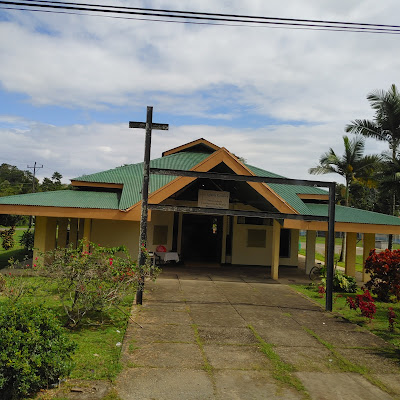 |
| Church. 60% of the country identifies as Catholic. |
 |
| There were little stores everywhere. |
 |
| Immature bunch of bananas. |
 |
| Dole sign as we entered a community. Notice all the roads are unpaved. |
 |
| Another small store but in this photo you can see the old railroad tracks that used to be used to transport bananas. |
 |
| Basketball court. |
 |
| I wonder if the satellite dishes are for different services or just generations of dishes as they changed technology. |
 |
| Many homes were on stilts. |
 |
| Bananas grow from the female flower while the male flower hangs from the bottom of the bunch. |
 |
| Red Ginger is grown as an ornamental plant. |
 |
| The bus driver spotted a troop of howler monkeys in this tree but the angle was wrong for me at the back of the bus. |
 |
| The driver moved the bus and I could finally see monkeys moving in the branches. |
 |
| Spider monkeys and white face Capuchin monkeys can also be found in Costa Rica. |
 |
| This is a cocao pod. There are 6 or 7 varieties of cocao, the start of that delicious treat called chocolate. |
 |
| Another river crossing on a one-way bridge. Actually, this is a canal that was made to carry wood when it was a major crop. |
 |
| Orange Poro tree in bloom |
 |
| Some fruits are toxic and have to be processed correctly in order to be eaten. These include tomatoes, passion fruit, mangos and cashews. |
 |
| Brahma cattle is raised because it can stand the heat and insects of Costa Rica. Their hide is tough to penetrate so this discourages ticks and flies. They are not grain fed so the meat is lean. |
 |
| We stopped at a fruit market. I didn't go inside but there were plants outside that had signs indicating what they were. |
 |
| This tree is native to West Africa but widely cultivated throughout tropical and subtropical regions for its edible fruit. It was taken to the Caribbean area with enslaved people from Africa, |
 |
| The soft fruit is eaten as a vegetable, though it is toxic, even fatal, if eaten unripe. |
 |
| You can see that the one on the bottom right has several flowers on it. That is because each cluster is made up of many fruits fused together. Pineapple is the same. |
 |
| The print is small on this so you might have to click on the photo to enlarge it for reading. |
 |
| What I really wanted was a photo of the red dragonflies. I'm used to blue dragonflies. But my camera and I weren't up to the task. |
 |
| Here's what one would look like if you got it to sit still. |
 |
| Loved these little ornamental pineapples that the guide showed us. |
 |
| Dole banana processing raceway that went over the road. |
 |
| Old containers made into a cafe. |
 |
| This bridge also had a separate pedestrian bridge. Our guide gave everyone a Cacao sweetie. These are cocao beans fermented and then roasted with caramel. I wasn't a fan. |
 |
| Costa Rican license plate. |
 |
| Sloths in the trees |
 |
| My sister saw one on the move during her excursion. Sloths have no natural predators. |
 |
| My sister saw this large spider during her excursion. I'm not sure but I think it might be a golden orb. |
 |
| Interesting barrel chairs on the dock. |
 |
| Back end of our cruise ship. |
 |
| Workers were busy painting the ship while it was docked. |
 |
| I ate my first ever Rueben on the ship. I've had one since that wasn't as good. |
 |
| January 9th was a day at sea so we did a puzzle. This one only had 13 pieces missing. |
 |
| Traveler Palms we saw as we walked ashore. |
 |
| Looks like the shoreline here is encased in mangroves. |
 |
| We just walked through the island, bypassing shops on our way to the boat that was transporting us to the mainland for our tour. |
 |
| There are many activities offered on and around the island, including jet skiing, fishing and ziplining. |
 |
| There was a lighthouse on the island and many different types of boats to take people off on different excursions. |
 |
| As we left the harbor, we sailed past the ship. |
 |
| On the boat ride to the mainland, we were told that proper response to the question, "How was your visit to Belize?" was supposed to be "Unbelizeable". |
 |
| Someone's private island. Might be Little Harvest Caye. |
 |
| Our first stop was the Belize Spice Farm and Botanical Gardens. We were here to see how the spies were grown and hear how they were harvested. |
 |
| Everyone funneled through this walkway to an area that contained trinkets and food for sale. This area has been a spice farm for 15 years and has 50 employees. |
 |
| I recognized the heliconia from a trip to Hawaii. There are different varieties of heliconia and I believe this is shrimp heliconia. |
 |
| We were greeted with a cup of orange juice. |
 |
| We walked out onto the patio, which had a area where we could easily board a trolley that was pulled by a tractor. The trolleys were made at the farm. |
 |
| I believe they called this a firecracker tree. |
 |
| The tractor operator would stop the tractor, hop off and collect parts of plants for us to feel and smell. This is a leaf off the sandpaper vine. Yes, it feels like sandpaper. |
 |
| The garlic vine naturally repels insects. |
 |
| Size of the bush and the tractor operator selecting vines for us to smell. Yes, it smells like garlic. We also were able to smell lemongrass. |
 |
| This is turmeric, a yellow ginger plant root. They pointed out the teak trees from SE Asia that are hard and slow-growing and a site where they are building cabanas so people can stay on the farm. |
 |
| Looks like they gathered coconuts and left them in a pile. Some were growing. |
 |
| These are curry tree leaves. They are used in many dishes in the Indian subcontinent. |
 |
| Moringa has been used for centuries due to its medicinal properties and health benefits. It also has antifungal, antiviral, antidepressant, and anti-inflammatory properties. |
 |
| Leaf of a cinnamon tree. Notice how the veins are parallel to each other. What we know as cinnamon is a shaving of the inner bark of the tree. It rolls up naturally when dried. |
 |
| Bilimbi, commonly known as cucumber tree or tree sorrel, is a fruit bearing tree and is a close relative of carambola. The fruit is sour. |
 |
| They built a picturesque bridge over a wetland and weddings are held there. |
The vanilla orchid is one of the world’s most interesting plants. Of the nearly 35,000 species of orchid, the second largest botanical family of plants, vanilla is the only species that produces an edible fruit. True vanilla is a sought-after product, usually the second most expensive spice in the world. This is the only orchid used for flavoring. The vanilla orchid is native to Mexico but is now cultivated in various equatorial regions, including Central America, Africa, and the South Pacific. More than 80 percent of the world's vanilla comes from Madagascar.
 |
| Typical homes seen along the way to our next stop. |
 |
| Along the top of one wall was a timeline of human development. Due to extreme glare, it was hard to get a readable photo. |
 |
| Information on the timeline could be divided into events happening in the world, those for Mesoamerica and those that were happening in Belize. |
 |
| Nim Li Punit was rediscovered by oil prospectors in 1976. Conservation began in 1980. Below is a photo of each stela followed by a photo of the description of the stela. |
 |
| Closeups of this description are the next two photos. Flint was used to create the stela inscriptions. |
 |
| Closeups of the words on this description follow. |
 |
| Some of the artifacts found at the site. |
 |
| Remember, click on the photo to enlarge it for reading. |
 |
| Our guide just waiting to show us the site. |
 |
| The front of the museum. You can see the stairs we had to climb to get to it. |
 |
| Like any ancient site, trees and other vegetation hide the structures. |
 |
| The fronds from the Heart of Palm tree are used to thatch roofs. |
 |
| Mayan observed thirteen twenty-day months plus 5 days to form each calendar year. |
 |
| Worn stela standing at E-Group. |
 |
| This is Stela #1 still in place at E-group. |
 |
| Stela #1 is on the Belize $2 bill. |
 |
| Mango tree at E-group. |
 |
| We walked a short distance to the location of Tombs 2 and 3. These were made with sandstone from the riverbed without any form of mortar. |
 |
| Mahogany tree located between Tomb #1 (under roof in background) and tombs #2 and #3. |
 |
| The bones are now at the Museum of Belize long with much of the rest of the items found at this site. |
 |
| Excavations took place between 1979 and 1986. |
 |
| Not much left of the royal residence. |
 |
| Gumbo limbo trees |
 |
| Huge termite nest that fell out of the gumbo limbo tree. These trees have smooth bark so they are slippery. |
 |
| Landscaping in front of the museum. |
 |
| When leaving the site, we had to walk through, or past, a vendor shelters and down a long, flight of stairs to get to the bus parking lot. The road to and from the archeological site is steep. |
 |
| Our guides grandparents live at the bottom of the hill, so he played at the ruins as a kid. |
 |
| This and the next six photos are sights along the way back to the pier. |
 |
| We took the shuttle boat back to Harvest Caye and boarded the ship. |
 |
| Beautiful end to another enjoyable day. |
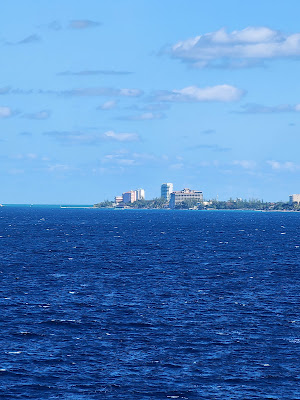 |
| Approaching San Miguel de Cozumel |
Looks like another ship beat us to the spot at the end of the pier. I figured we were going to dock on the side of the pier behind this ship.
 |
| But no, we went around the front then backed alongside the pier. |
 |
| In place but not yet secured so the dock crew could start getting ready for passengers to depart. |
 |
| At the end of the pier, I joined the group for my excursion. Many other excursions were meeting in the area pictured. |
 |
| While I got on a bus, my sister got on this boat to go to her submarine trip. |
 |
| Saw this figure in front of the tequila tasting place. Maybe a representation of a tamandua anteater? |
 |
| A little further down the road we stopped at the Myan Cacao Company. |
 |
| There were shops in the yellow buildings, but we headed straight to our tour. |
 |
| The tour ended at this shop that we had passed on our way in. |
 |
| Our guide stopped in front of a mural to explain the Mayan numbering system. Terrible photo, huh? That's just how the shadows were hitting it when I was there. |
 |
| Searching online, I found two photos, that when put together, show most of the mural. |
 |
| Mayan numerals are made up of three symbols; zero (a shell), one (a dot) and five (a bar). So here we see zero, one, two, three, four. five and six. |
 |
| This would be ten, eleven, twelve, thirteen and part of fourteen. |
 |
| Numbers after 19 were written vertically in powers of twenty. This set represents 2014. |
 |
| Click on the photo to enlarge for reading. Monkey helped the Mayans find cocao beans. The beans gave the monkeys energy from the caffeine. |
 |
| Only the highest classes of Mayans were allowed to have cocao. It was given to warriors. |
 |
| There are 24 to 40 beans in each pod. |
 |
| A young cocao plant |
 |
| This bird messed with me for a while as I tried to take a photo. It would make sure it had its back to me, but I finally caught its profile. |
 |
| Homes sometimes had two levels of hammocks. |
 |
| A Mayan home might have an Alter for the Dead. |
 |
| Well |
 |
| Sign with information about Melipona honey |
 |
| As we entered the exhibit hall, we were given a bite of chocolate that they had made like the Mayans original created it. It was a little crunchy. |
 |
| He ground the seeds on this motor then proceeded to add different ingredients, including allspice, cinnamon, Small red seed paprika, hot water, sugar, honey, and vanilla. |
 |
| At the end of the tour we were led through a shop where we had the "opportunity" to buy chocolate. They gave out samples. The dark chocolate mint was very good but each bar costs $9. Ouch! |
 |
| The toilet didn't' have a seat and the flush lever was off to the side. |
 |
| Fancy cocao pod sinks. |
 |
| Our next stop was the El Mirador Lookout Point. |
 |
| The bus we traveled in. |
 |
| Shops lined up at the lookout point were just waiting for tourists to buy their goods. |
 |
| This poster showed where the different kinds of agave are grown and what type of liquor they produce. They gave free samples of mescal. |
 |
| Loved this artwork made out of a coconut. |
 |
| There's no electricity on the east coast of the island. Turtles nest on this side. |
 |
| View of the road as the bus turned into the next spot. |
 |
| Bee made out of vines hung above the entrance. |
 |
| The first stop was to watch a guy, speaking in Mayan, do a Mayan ceremony. |
 |
| We walked along a path toward the bee hives. |
 |
| The bees make their homes in dead wood. Since ants are enemies of bees, these logs were put inside a trench filled with water. |
 |
| See the little hole? That's the entrance to the hive. |
 |
| I could see the bees moving around in the hive. |
 |
| Melipona bees are more the size of a house fly, and only produce a liter of honey a year. European bees produce 30 to 40 liters. |
 |
| Melipona honey has many medicinal uses, including for allergies. |
 |
| There are over 10,000 cenotes in the Yucatan peninsula. |
 |
| Our next stop was to taste the honey. |
 |
| Interesting sinks at the Bee Sanctuary. |
 |
| Trash cans made out of tires. |
 |
| Back to the port, we arrived after the All Aboard time so there was no chance to do any shopping. |
 |
| The next morning we were back in Miami at the dock when the Norwegian Sky passed by us. I laughed because we were on the Viking Sky cruise ship in 2021. |







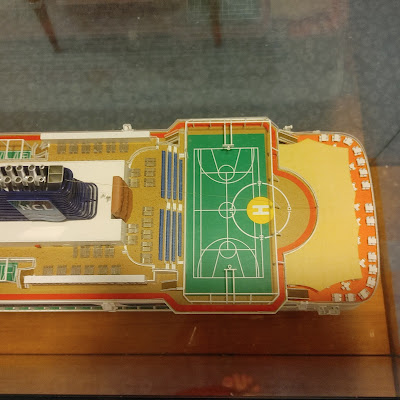



















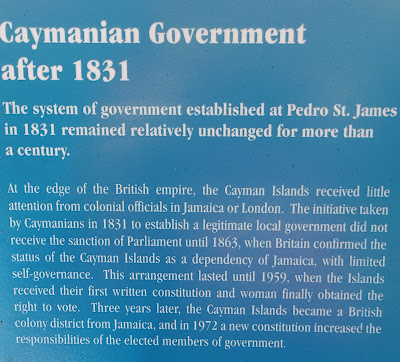





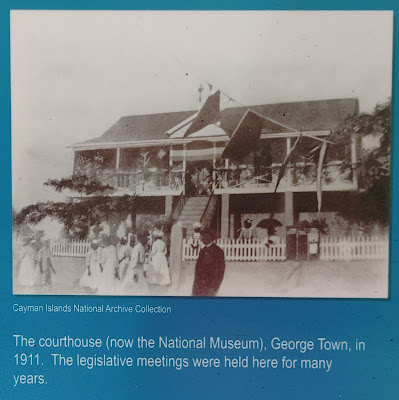














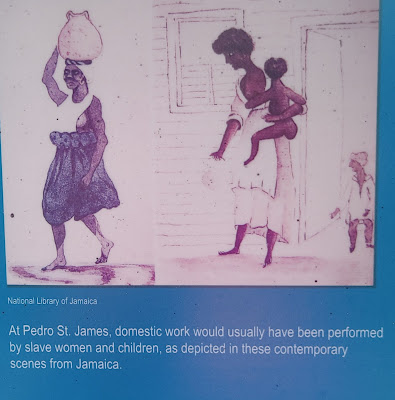
















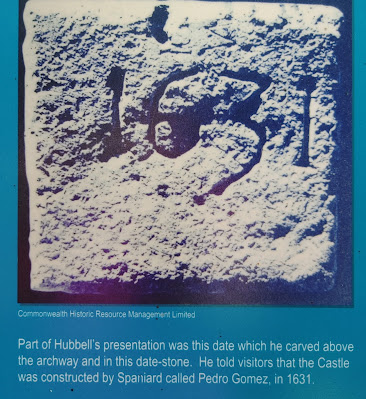
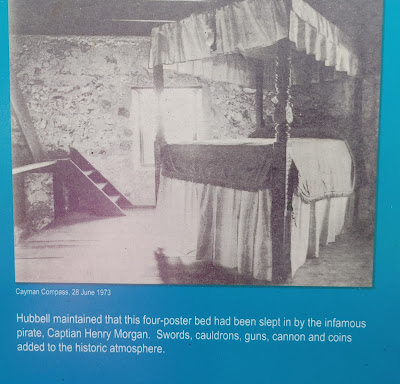


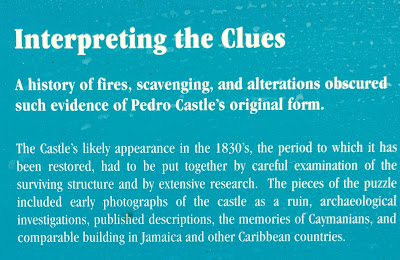









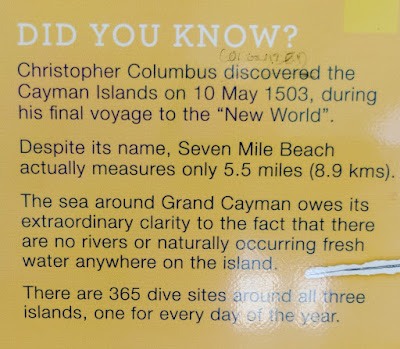

















































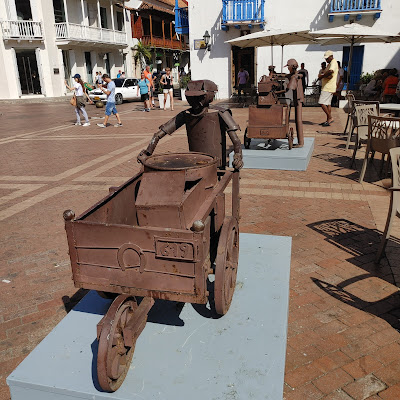















































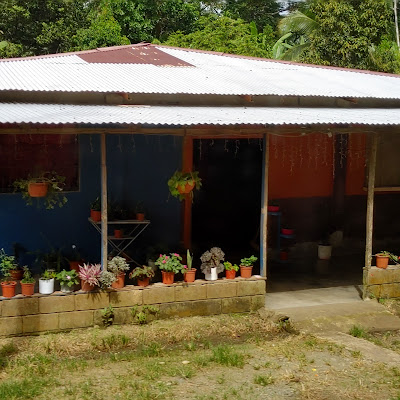




































































































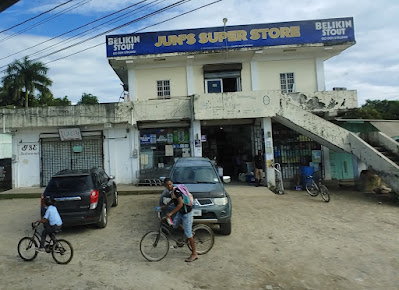
















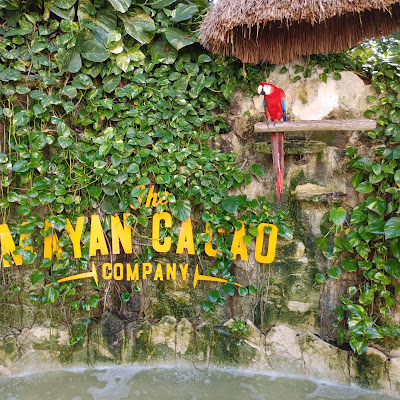





























No comments:
Post a Comment